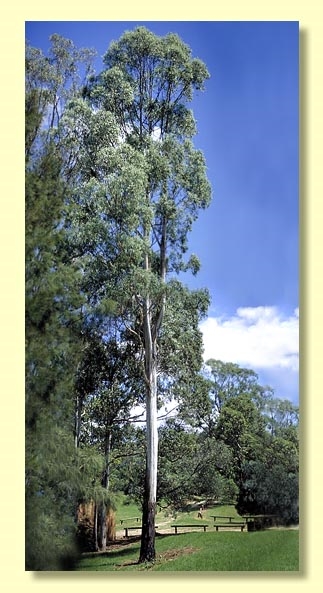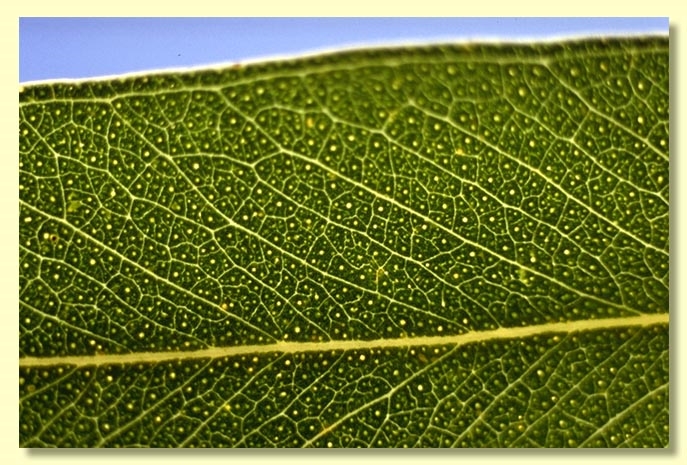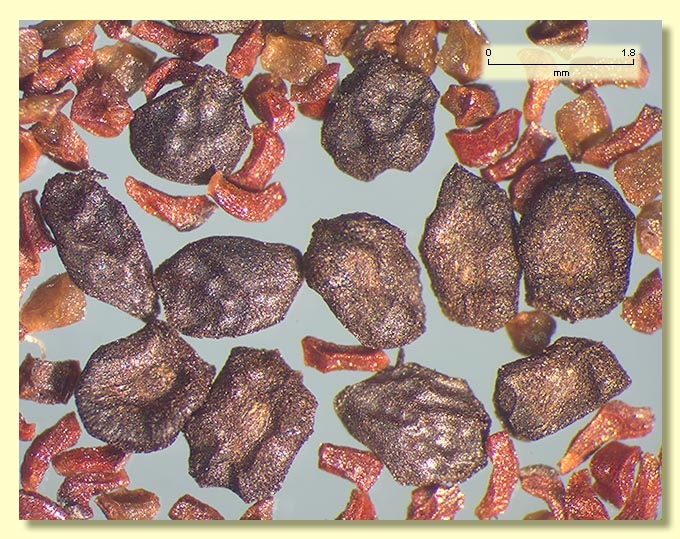Euclid - Online edition
Eucalyptus benthamii
Eucalyptus | Symphyomyrtus | Maidenaria | Triangulares | Benthamianae
T: Nepean R. near Cobbity, NSW, June 1913, J.H.Maiden & R.H.Cambage s.n.; holo: NSW; iso: BM.
Bark smooth throughout or with partially adherent brownish rough bark at base of trunk, smooth bark bluish grey or white, branches ribbony.
Juvenile growth (coppice or field seedlings to 50 cm): stem rounded in cross-section, often slightly glaucous; juvenile leaves opposite and sessile for many pairs, ovate to cordate, 3–9 cm long, 2–4 cm wide, bases amplexicaul to rounded, blue-green or slightly glaucous.
Adult leaves alternate, petiole 0.5–3.5 cm long; blade lanceolate to falcate, 8–23 cm long, 1.2–2.7 cm wide, base tapering to petiole, concolorous, glossy or dull, green, side-veins at an acute or wider angle to midrib, moderately to densely reticulate, intramarginal vein parallel to and just within margin or well-removed from it, oil glands island.
Inflorescence axillary unbranched, peduncles 0.4–0.8 cm long, buds 7 per umbel, sessile or on pedicels to 0.2 cm long. Mature buds obovoid to ovoid, 0.3–0.5 cm long, 0.2–0.4 cm wide, green to yellow or glaucous, scar present but near top of bud because only apical part of outer operculum is shed, operculum rounded, stamens inflexed, anthers cuboid to oblong, versatile, dorsifixed, dehiscing by longitudinal slits (non-confluent), style long, stigma blunt, locules 3 or 4, the placentae each with 4 vertical ovule rows. Flowers white.
Fruit sessile or on pedicels to only 0.1 cm long, cup-shaped, campanulate or obconical, 0.3–0.4 cm long, 0.4–0.6 cm wide, often glaucous, disc raised and annular or convex, or disc level, valves 3 or 4, exserted or near rim level.
Seeds dark brown, 1–1.8 mm long, ovoid or flattened-ovoid, scarcely lacunose, dorsal surface smooth or shallowly pitted, hilum ventral.
Cultivated seedlings (measured at ca node 10): cotyledons bilobed to oblong; stems rounded in cross-section, glaucous; leaves sessile and opposite for many nodes, cordate, 2.5–5 cm long, 2–3.5 cm long, amplexicaul, glaucous to blue-green.
Flowering has been recorded in March, April, May, July and September.
A medium-sized to tall, rare tree occurring in few stands from the Camden district north-west towards the Blue Mountains west of Sydney, particularly on flats of the Nepean River.
E. benthamii is not closely related to any other species. It is notable for the smooth white, often massive trunk although the basal 1–2 m are often rough, for the sessile, ovate, glaucous juvenile leaves, and particularly the buds from which the outer operculum does not shed distinctly but comes off as a more or less square scale from the top of the bud. This anomalous operculum character can also be seen in E. denticulata and E. sturgissiana but in no other eastern species.
Eucalyptus benthamii belongs in Eucalyptus subgenus Symphyomyrtus section Maidenaria subsection Triangulares, a group of species more or less restricted to south-eastern Australia, characterised by bilobed cotyledons, simple axillary inflorescences, buds with two opercula, stamens with versatile anthers and flattened seeds with a ventral hilum, and juvenile leaves soon petiolate and alternate on the stems. Within this sub-section E. benthamii is isolated in the monotypic series Benthamianae because of its unusual outer operculum, largely smooth bark and buds in sevens.
Eucalyptus benthamii is listed as "Vulnerable" under the Australian Government Environment Protection and Biodiversity Conservation Act 1999 (EPBC Act). Further information may be found at this web address:
http://www.environment.gov.au/cgi-bin/sprat/public/sprat.pl














